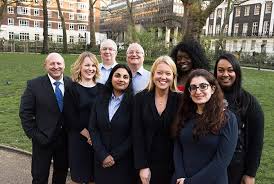 At Voice At The Table, we’ve been working on developing inclusive cultures for some time now: identifying the starting point, describing the look and feel of an inclusive workplace, and supporting our clients in designing and developing their own inclusive and diverse teams.
At Voice At The Table, we’ve been working on developing inclusive cultures for some time now: identifying the starting point, describing the look and feel of an inclusive workplace, and supporting our clients in designing and developing their own inclusive and diverse teams.
In this new series of posts, we will be scoring organisations on their attitude to diversity and inclusion. Assessing companies’ culture relative to our own Inclusion Criteria, we give them an Inclusion Mark, gauging where they are on the journey towards a strong inclusive culture that nurtures diverse thinking and garners its many benefits.
Our 7 Inclusion Marks describe the various stages of that journey:
- Don’t Get It! – organisation doesn’t see any benefit from Diversity & Inclusion
- Window Dressing – organisation understands the need to be seen as valuing D&I
- Let’s Fix It! – organisation sees lack of diversity as a problem.
- Seeing The Opportunity – organisation understands the strategic importance of D&I
- Building the Foundation – organisation is actively building a foundation for D&I
- Growing & Nurturing – organisation is starting to reap the benefits of D&I and continues to embed them into the business
- Immersed & Fully Benefiting – organisation has established a successful inclusive culture that benefits from the full value of its diverse workforce
This time we look at Lyndales Solicitors, a boutique firm. With a practice that ranges from civil litigation to family law to commercial property to private clients to company commercial, this firm punches above its weight.
But how well does it fair in diversity and inclusion terms?
The first thing one notices when looking at the team of solicitors at Lyndales is how diverse it is. The Lyndales team is small and perfectly formed, gender-balanced at 50-50, with representatives of different ethnic and racial backgrounds. Granted, at partner level the firm is striving towards diversity (with only 1 of 5 partners being a woman), but if we judge by appearance only, it would seem the firm is keen to address this nuance. And, while the team of lawyers is relatively small, it also spans a number of generations (the youngest member being in their 20s whereas the oldest in his late 60s), adding to the mix of views, experiences and opinions of the group.
Having interviewed one of their senior solicitors, Noga Kogman, I quickly reached the conclusion that the firm is aware of the benefits of diversity and inclusion as a business proposition and is shaping its work environment to attract and retain a diverse mix of people.
How do Lyndales measure up to our Inclusion Criteria?
- Working Culture
Noga moved to London from Israel and, as a mother of a young child who is ambitious and career-minded, Noga wanted to work at a firm that can offer her an intellectually-stimulating role and also let her be a mother on her own terms. Lyndales offered her just that. Working a full 5-day week, Noga usually works from home once a week and on another day leaves the office at 4pm to pick up her son. Noga is also free to make other arrangements needed to accommodate her role as a parent and a commercial transaction lawyer. Noga doesn’t have to hide that she’s leaving to look after her son and doesn’t feel judged because of it. She feels fully respected and valued by all her colleagues and is therefore able to be fully herself in the office.
In fact, one third of the lawyers work from home one day a week (including a male member of the team) and one of the solicitors also works a shorter week in addition to one of her work days being from home. In other words, the firm accommodates agile working for everyone who wants it.
Noga describes the culture at Lyndales as healthy and open-minded. The partners trust their colleagues to be professionals and don’t second-guess how or where they get the job done. Performance is measured by output and everyone’s targets and progress is openly discussed at team meetings. People are engaged, committed and happy to be at work – a testament to a tolerant, respecting culture.
Noga feels that there is a genuine interest in diversity at the firm, beyond it being a requirement imposed by the SRA. The firm has an open-minded approach to candidates and views CVs without regard to a person’s background, name or gender. The firm is genuinely interested in attracting people from various backgrounds (reflected in the composition of the legal team).
Interviews are conducted by a wide group of people to ensure a lack of bias and a good personality fit with all. It is therefore not uncommon that lateral hires come from bigger City firms to find a home that respects their varied backgrounds and values their technical skills.
When asked about the firm’s leadership style, Noga explained that the partners are inclusive and considerate. Noga and her colleagues are routinely engaged in most decisions that affect them directly, from office moves to new hires. Partners consult with their colleagues regularly and listen and act on feedback. Partners can be described as balanced in their attitude, open-minded and professional and the tone for the firm’s culture and business is set by its managing partner.
- Retention, Development and Promotion
In terms of retention, Lyndales story is strong. Most lawyers stay for a long time, with hardly any turn-over of legal staff. The two longest serving partners are the founders, each with 40 years under his respective belt. The firm recently expanded with 3 lateral hires and a newly-qualified solicitor who trained with the firm. The female partner at the firm returned from maternity leave to work flexibly, working 4 days per week, one of which is from home.
Lyndales do not offer special arrangements for parenting, such as maternity coaching or specific policies around maternity, although one might argue that, with an open attitude towards accommodating most flexible working requests and a friendly open-minded environment, such support services aren’t strictly necessary. The firm’s maternity leave is comparable to that of any bigger firm and it encourages fathers to play their role in child care.
The firm encourages lawyers to maintain their personal development, supporting their individual training initiatives. As a small firm, it doesn’t have a central training department yet encourages each person to think about their own growth.
As with most other law firms, the path to equity partnership isn’t entirely transparent, but according to Noga, the partners are aware of this and are keen to address it. The managing partner has taken it upon himself to ensure the partnership track is transparent and is actively working on making it so.
- Diversity as a Market Force
The drive for a diverse and inclusive culture in this case is not coming from the outside world. While it would be fair to say that clients do think about diversity and prefer to work with diverse and able teams (and, as a result, benefit from their more creative and insightful solutions), in the case of Lyndales the firm culture is naturally inclusive and is designed to give lawyers independence, responsibility and accountability. As a result, the firm benefits from the diversity of its people by allowing them to bring their whole selves to work and tap into their diverse backgrounds and experiences.
- External Evidence of Commitment
In terms of the gender pay gap, the firm is too small to have to report on it, but internal sources suggest that there is a gender pay gap at the firm (currently not quantified), as a function of the fact that, at partnership level, there are more men than women.
The firm is not a signatory to any diversity charters (including the legal diversity and inclusion charter) and is too small to need Employee Resource Groups or networks.
This short overview of the firm’s culture against our criteria leads us to award Lyndales Solicitors an Inclusion Mark of Growing and Nurturing their existing inclusive and diverse culture. This puts the firm in a prominent position in the legal industry, proving that D&I is not something that pertains only to bigger organisations. As a diverse and inclusive culture is something that can be nurtured from the outset, the size of the business doesn’t matter. Small businesses like Lyndales stand to benefit from an inclusive environment as much as (if not more than) any bigger organisation that puts D&I front and centre to its growth strategy. Congratulations, Lyndales! You’ve accomplished a remarkable feat without trying too hard!
If you would like us to review your organisation’s diversity and Inclusion Mark, please email info@voiceatthetable.com








 Pink didn’t start out as a colour of girls. In fact, in the 19th century, pink was a colour associated with boys. As red was the colour closely-associated with men, pink – a lighter shade of red – was the colour most often chosen for little men, as boys were then regarded.
Pink didn’t start out as a colour of girls. In fact, in the 19th century, pink was a colour associated with boys. As red was the colour closely-associated with men, pink – a lighter shade of red – was the colour most often chosen for little men, as boys were then regarded.
 Guest blog by
Guest blog by 
 At Voice At The Table, we’ve been working on developing inclusive cultures for some time now: identifying the starting point, describing the look and feel of an inclusive workplace, and supporting our clients in designing and developing their own inclusive and diverse teams.
At Voice At The Table, we’ve been working on developing inclusive cultures for some time now: identifying the starting point, describing the look and feel of an inclusive workplace, and supporting our clients in designing and developing their own inclusive and diverse teams.